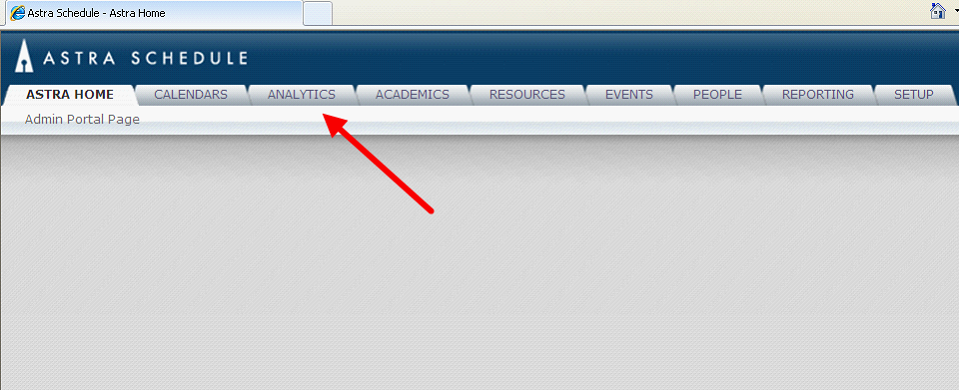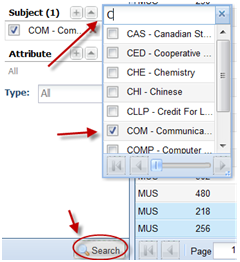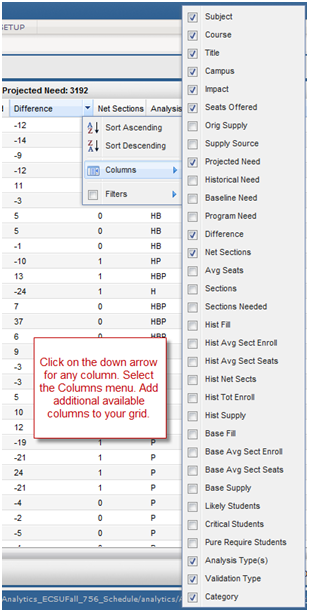
Analysis Results - Course Lists |

|

|

|
|
Analysis Results - Course Lists |

|

|

|
|
|
||
Once analysis have been completed, the results for each run may be reviewed in detail.
To access an analysis run, perform the following:
1.Log in to Astra Schedule.
2.Click on the Analytics tab.

3.Click the link for Sandboxes.
The Sandbox list page is opened, displaying any previously saved Analysis Runs in addition to any other analysis sandbox files. An Analysis Run is comprised of the settings defined for the specific analysis, and optionally the results of the analysis that can be reviewed at any time. The Analysis Run list displays the run name, status of the run’s progress, the user that created the run, and the date the run was last updated.

When viewing the Analysis Run list, click the label at the top of any column to sort the list.
4.Click on the name of a completed run to view the results of the run. The analysis data will appear for review.
Using filters
Within the analysis results data, you may search for specific courses by entering data in the Filter area on the left side of the page. You may search by any combination of: Campus, College, Department, Subject, and/or Attribute. You may also select by one of the following: All Courses, Under Supply, or Over Supply.
Click the plus sign to activate the modal to allow you to select filters. Once finished. Click Search to execute the filters.


![]() TIP: Click the Filter controls arrow to collapse the filter panel.
TIP: Click the Filter controls arrow to collapse the filter panel.
Data Grid Features
•Pagination
At the bottom of the grid, you can move to the next page, last page, previous page, or first page by using the arrow buttons provided. You can also type in a specific page number.
•Export to Excel
Each grid can be exported to Excel by clicking on the Export to Excel icon at the bottom of the page. Raw table results can also be viewed by clicking on that icon.
•Sorting
Click on the header of any column to sort by that column. Click twice to change the sort order. Another method is to click on the down arrow beside the column heading and select Sort Ascending or Sort Descending.
•Column Order
To change the order of the columns, click on the column and move it to the desired location.
•Filtering
To filter the data in a column, click on the down arrow by the column. If the column is numeric, you will be able to filter by greater than, less than, and equal to values. If the column is alphanumeric, you will be able to enter a search string.
The analysis course results screen offers a tabbed approach to reviewing the course results. In addition to the “All Courses” tab, the institution has the opportunity to focus efforts around change candidates, courses for further review, and courses that require no immediate action. All of the grid pages in Platinum Analytics allow for functionality around sorting, filtering, adjusting column order, and adding or removing columns to customize the users’ view.
The analysis course list page is the main results page for the analysis run detailing the courses included in the analysis based on data filters. This page is initially sorted by most undersupplied to most oversupplied to highlight where an institution may need to offer additional seats. These pages can be evaluated in different ways to draw appropriate conclusions.

Header Descriptions:
•Total Rows
Total number of courses included in the analysis run (based on the filters selected)
•Total Sections
Total number of sections offered for the analysis term (based on the filters selected)
•Seats Offered
Total number of planned seats for the analysis term for all courses included in the analysis run (based on the filters selected)
•Projected Need
Total number of seats needed for the analysis term for all courses included in the analysis run (based on the filters selected)
Column Descriptions:
•Subject
Subject code for the course
•Course
Course number for the course
•Campus
Campus where the course has been offered (historical analysis) or where students may need to take the course (program analysis)
•Impact
Shows the severity of the changes needed
•Reliability
Indicates how reliable the candidate data is based on a series of pass/fail tests
![]() NOTE: The combination of high impact and high reliability create the most important changes on which to act. These are the "pearls" in the findings.
NOTE: The combination of high impact and high reliability create the most important changes on which to act. These are the "pearls" in the findings.
•Seats Offered
Planned seats for the analysis term (sum of the maximum enrollment on each of the sections offered)
•Projected Need
Weighted average of the seats needed based on the analysis type(s) used (as defined in the analysis run setup)
•Difference
Delta between the seats offered and the blended need
•Net Sections
Indicates the recommended changes to the sections offered; negative numbers are sections that may be unnecessary; positive numbers are sections that may be added. Calculated by dividing the projected need by the average section size for the analysis term and comparing that value with the sections offered
•Analysis Types
Indicates the type of analysis used to derive the demand.
H – Historical Trend
B – Baseline
O - Objective Program
P – Predictive Program
•Validation Type
Assists with validating the results of the data based on the calculation of demand
•Category
Indicates the recommended course action based on the results. The categories are also represented as tabs in the interface. Detailed descriptions of the criteria used to place the courses into categories are included in the next section
Change Candidate Categories: Courses that may require action on the part of the institution to make schedule adjustments to greater align course offerings with the demand
Addition – Addition Candidates
Reduction – Reduction Candidates
Elimination – Elimination Candidates
Categories for Further Review: Courses that may require additional review to explain the analysis results.
Program – Program Only
Historical – Historical Only
Program High – Program High
Historical High – Historical High
No Action Needed: Courses do not require action; demand roughly aligns with seats offered.
**Courses that have cross-listed sections are highlighted in blue for that row.
Additional Columns
Each screen grid in Platinum Analytics has the option to display additional “hidden” columns. The columns described above are the base columns available in the Analysis Results screen. Additional columns may be accessed from the grid menu on any of the existing column headings.
To access additional columns, click the down arrow next to a column heading, select the Columns menu, and select the columns you wish to add to your grid. Columns should dynamically appear in the grid. To close the menu, click anywhere else on the page.

Additional Column Descriptions (Analysis Results):
•Orig Supply - seats offered from the student information system if Analytics adjusted the seats offered to account practices of holding seats
•Supply Source - indicates whether the seats offered came directly from the student information system or if an adjustment was made
•Historical Need – demand from the Historical Trend analysis type
•Baseline Need – demand from the Baseline analysis type
•Program Need – demand from the Program Analysis analysis type
•Avg Seats - average section size for sections offered in the analysis term; total maximum enrollment on all sections divided by sections offered
•Sections – sections offered for the course in the analysis term
•Sections Needed – calculation of the sections needed based on dividing the projected need (weighted average of the analysis types used) by the average section size for the analysis term
•Hist Fill - another term for enrollment ratio. Total enrollment divided by total max enrollment for each course
•Hist Avg Sect Enroll - average section enrollment for the historical like terms
•Hist Supply - the total seats offered over all historical like terms
•Base Fill - baseline enrollment ratio; Comparison of enrollment versus max enrollment in the baseline term
•Base Avg Sect Enroll - average section enrollment of the baseline term
•Base Avg Sect Seat - average section seats offered in the baseline term
•Base Supply - total seats offered for the baseline term
•Likely Students - students who have a greater than fifty percent probability of taking the course in the analysis term
•Critical Students - number of students who have the course as a pure or absolute requirement and are likely (greater than 50% probability) to take it in the analysis term
•Pure Require Students - this one is the number of students who have the course as an absolute requirement
Courses in this category should be reviewed to determine if additional sections of the course should be added in order to meet the demand. Using the criteria listed below, these courses have strong indications from historical and program analysis that additional seats may be needed.
Criteria
•Undersupplied by at least half the size of an average section or more than 10 seats of there are no sections offered in the analysis term
•Average fill ratio among like/baseline terms is above 90%
•Has been offered during the historical trend period
•Program analysis is no more than 3 times historical trend
Courses in this category should be reviewed to determine if sections of these courses can be cut from the schedule and still meet student demand. Using the criteria listed below, these courses have more seats than needed, and the historical information indicates that the courses have not been filled in the past. In reviewing these courses, other criteria may determine that the additional sections may need to remain on the schedule (low enrollment sections are a part of a special program such as honors or those sections may support an evening or weekend program).
Criteria
•Oversupplied by the average size of a section (allowing you to cut a full section and meet demand)
•Average fill ratio among like/baseline terms is lower than 80%
•Application finds at least 1 Reduction Candidate for Analysis Term; Reduction candidate is calculated by determining the demand for the analysis term divided by the average section size to give a number of sections needed. This value is compared with the sections offered. If this comparison is greater than one, the application indicates a reduction candidate.
Courses in this category should be reviewed to determine if these courses can be cut from the schedule. The demand is low, and the sections offered in the past have been under-utilized. These courses should be reviewed in program analysis to determine if any students have these courses as absolute requirements, and if so, the probability or likelihood that they need to take the course in the near future.
Criteria
•Oversupplied
•Projected Need is less than 10
•Average fill ratio has been less than 50%
Courses in this category should be reviewed for accuracy. There are legitimate reasons why courses only have program analysis demand:
•New courses/programs that have never been offered
•Courses that are only offered in an alternate term (Analyzing fall terms, but these courses are only offered in spring)
•Active courses are included in program requirements but are no longer offered
If these legitimate reasons do not apply to the courses in this tab, the courses should be reviewed in more detail to determine if data issues exist.
Criteria
•Program analysis demand exists for the analysis term
•No historical analysis demand exists for the analysis term (trend and baseline)
Courses in this category should be reviewed for accuracy. Potential reasons for why courses are in this category:
•Significant program demand exists that has never been reflected in the historical offerings
•Significant program demand exists possibly due to limited offerings in the past, reflecting high accumulated demand
Reviewing these courses by fill ratio can be helpful. If the fill ratios are over ninety percent, the results may be accurately reflecting demand. If fill ratios are lower, it may be helpful to look at individual section offerings to determine if certain sections are under-enrolled for some reason. In addition, program requirements and their interpretation in the analysis should be reviewed.
Criteria
•Program analysis demand is greater than three times historical demand
Courses in this category should be reviewed for accuracy. Potential reasons for why courses are in this category:
•Course is an elective but not required by any program
•Course is a requirement but only a part of a very large (usually more than 100 choices) list
If courses in this group are program requirements, the analysis should be reviewed to determine why the program demand is not being recorded.
Criteria
•No program analysis demand exists for the analysis term
•Historical analysis (trend and/or baseline) exists for the analysis term
Courses in this category should be reviewed for accuracy. Potential reasons for why courses are in this category:
•Course is a popular choice in a requirement group
•Course is a popular elective
Predictive program analysis (available in 7.6.x) will assist with addressing this issue. This additional analysis type combines the more objective program analysis with historical offerings to determine which courses are more likely to be selected when presented with a choice.
Criteria
•Historical analysis demand is greater than three times the program analysis demand
Courses in this category do not fall into one of the other categories. The historical and program analyses seem to indicate that the offerings are in line with the demand. While these courses may also be reviewed, the analysis does not indicate any action is required in the schedule for this analysis run.
Criteria
•Does not meet criteria for “candidates” or “outliers”